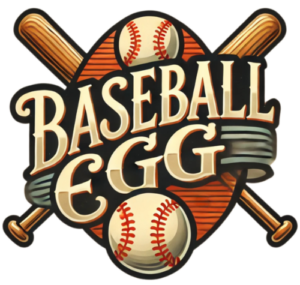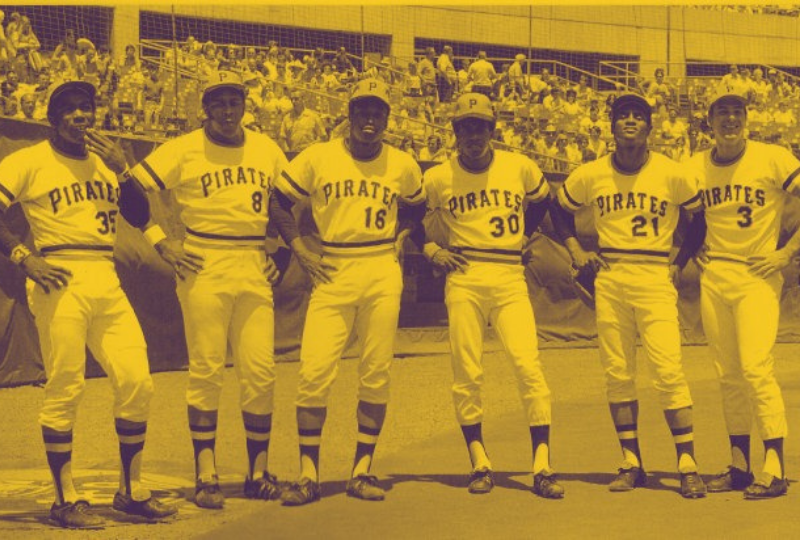In baseball if your team gets a nickname it’s a sign that things are going well. Bad teams don’t get nicknames.
In the 1970s the Pittsburgh Pirates were (next to Cincinnati) the most successful team in the National League. Led mostly by their explosive offense, the club’s lineup became known as “The Lumber Company”. The players who provided the “Pop! Pow! and Punch!” for the Bucs were hard-hitters who terrified pitchers in the NL, and AL hurlers twice in the World Series.
The first team to earn “The Lumber Company” label was the ’71 Pirates, a team that won the World Series in thrilling fashion over the Baltimore Orioles. That Bucs team led the league with 788 runs scored, and they often scored them in batches that buried their opponent. In one June series against the Phillies, the Pirates won 14-4, 11-9, and 10-9. They followed that up by burying the Cardinals 11-5 in their next game. That team scored 10 or more runs 21 times on their way to their first pennant in 10 years.
Original members of the Lumber Company
The original members of The Lumber Company were Roberto Clemente, Willie Stargell, Bob Robertson, Al Oliver, Richie Hebner, and Manny Sanguillen. Second baseman Dave Cash, a fleet-footed singles hitter, was the leadoff man and table setter.
It was this core group (minus Clemente who died tragically in a plane crash on New Year’s Eve in 1972), who led the Pirates to the playoffs five times in six seasons from 1970-1975. Unfortunately, the Bucs ran up against the Reds three times and lost the NLCS each time. The pennant in 1971 was the only flag the Pirates won during that six-year run.
The common thread in the Pirates’ lineups of the 1970s was Stargell, an imposing slugger who emerged as a team leader following Clemente’s passing. Stargell had incredibly strong wrists and a quick bat that produced lethal line drives. “Pops” won two home run titles and an MVP Award during the 1970s, and in 1973 he captured 2/3 of the Triple Crown.
Whereas Stargell provided punch from the left side, Robertson was a right-handed power hitter. Before back injuries slowed him, Robertson hit 27 homers in 1970 and 26 more the next season. Still, he was a key part of the team until 1976.
No batter hit the baseball hard more often than Oliver, who played center field and first base when needed. Oliver led the league in “atom” balls, or line drives that were hit right at fielders (“He hit it right at ’em“). Oliver bated .298 for the Bucs from 1970-1977, with 80 or more RBI six times. He was one of three Lumber Co. batters who would win a batting title.
Sanguillen never met a pitch he didn’t like. The Panama native hit .300 in each of his first three seasons in the majors, often batting right behind Cash in the number two spot in the Pirates lineup. “Sangy” pummeled Orioles’ pitchers in the 1971 Series, collecting 11 hits and batting .379 in the seven games. Later he became one of the few players traded for a manager, but he was always a Pirate first.
The Pirates piled runs up during the decade. When enemy teams saw they were slated to play Pittsburgh, they made sure their bullpen was well rested. The Bucs led the NL in 1971 with 788 runs; were 3rd in 1972; 4th in ‘193; 3rd in 1974, 1975, and 1976; placed 5th in 1977; 4th in 1978; and in 1979 they led the league with 775 runs. That season, Pittsburgh won the NL East for the sixth time in the decade.
The Lumber Company had a knack for scoring runs quickly and often, while getting hits in bunches. While the Reds used speed to generate scoring opportunities in addition to their power attack, the Pirates relied almost exclusively on a barrage of base hits. On September 16, 1975, second baseman Rennie Stennett tied a big league record by banging out seven hits in a game.
Adding to their already potent attack, Richie Zisk arrived in 1973. A big, strong, right-handed hitter from New Jersey, Zisk could hit the ball as hard as Oliver and as far as Stargell, though he was less consistent. He won an outfield slot as a rookie and promptly hit .300 his first two seasons as a big leaguer.
The Cobra
In 1974, an even more fearsome figure made his way into the Pirate lineup. Dave Parker was 6’5 and 230 pounds, with legs that seemed to never end and arms that could reach anything near the plate. But he was especially fond of pitches on the inside part of the dish, which he stood right on top of. The right fielder was so good that he finished third in NL MVP voting in his first full season as a major leaguer. He won the batting title in 1977 and liked that so much that he won it again in 1978, hauling away the MVP trophy too. That year, Parker was a monster, leading the league in slugging, batting, and in making opposing pitchers wet their pants.
“Until I joined the Pirates I’d never realized how big Dave Parker was,” teammate Phil Garner said. “I’d put him up against the French Army.”
Parker was confident in himself too, and he had every right to be. In the late summer of 1978, when his average was hovering around the .300 mark and several batters ahead of him in the batting race, Parker shrugged away any doubt.
“When the leaves turn brown,” Big Dave predicted, “I’ll be wearing the batting crown.” Parker hit .412 from August 7th to the end of the season and won the 1978 batting title.
It was somewhat incredible that Parker was even in the lineup to win that second silver bat. On June 30th he broke his cheekbone and fractured his jaw in a collision with a catcher at home plate. “The Cobra” missed three weeks of the season, though he didn’t want to.
“He wanted to play the next day!” trainer Tony Bartirome said. But the Pirates convinced their prized star to wait. When he came back a few days later, Parker found a way to be even more intimidating. Parker wore a hockey-style mask on his face to protect his cheekbone. It was a frightening device painted gold and black. Later, he wore a football style face mask. No matter, he still hit in Pirate fashion.
Though they had a clubhouse filled with great hitters during the 1970s, the Pirates were always on the lookout for more. Just prior to the start of the 1975 campaign they acquired Bill Robinson from Philadelphia. Robinson had once been a highly touted prospect in the Yankee organization, tabbed by some as the next Mickey Mantle. But instead he became the first Bill Robinson, forging a fine career as a jack-of-all-trades, sort of a Swiss Army Knife with a bat. Robinson could play five positions, and no matter what glove he wore, he hit. In his first season in the gold and black of the Pirates, Robby hit 21 homers, and since he was a Pirate, of course he also hit .300 his first two seasons in the black-and-gold. The big power hitter averaged 19 homers a season in his first five seasons in the Steel City, and he delivered a clutch hit in Game Seven of the 1979 Series. He was another piece of wood in The Lumber Company.
A key bat on the 1979 World Series champions was “The Hammer”, John Milner. A veteran who spent the first seven years of his career with the New York Mets, Milner brought his hitting shoes with him to Pittsburgh and was rejuvenated playing with the great hitters who were now his teammates.
Amazingly, yet another excellent bat arrived in 1979 when Bill Madlock was acquired from the Giants in mid-season. The fiery Madlock was a two-time batting champion and the Bucs only had to give up three pitchers to get him. In Pittsburgh who needed pitchers anyway?
With “Mad Dog” on the 1979 team the Pirates had two batting champions, one future batting champion, two MVP award winners, and a score of terrifying hitters in their lineup. Their explosiveness was on display in Atlanta in early May: the Pirates and Braves battled back and forth, and after seven innings the Pirates held a slim 10-9 lead. The Bucs had already banged out 10 hits, but in the top of the ninth they decided to really let the lumber fly. The Pirates erupted for seven runs, the big blow a grand slam by Milner. Relief pitcher Kent Tekulve even got a hit!
The 1979 season and The Family
On the morning of the last Monday of the 1979 season, the Pirates were a half-game back of the young Montreal Expos as the two teams prepared for a four-game series in Pittsburgh. The team split the first two games before The Lumber Company took charge, pounding out 10-4 and 10-1 victories to move 1 1/2 games ahead, and edged the Expos for the NL East title.
Wouldn’t you know it? The Bucs faced their nemesis, the Reds, in the 1979 NL Playoffs. It was a clash between the two great teams in the league during the 1970s, a clash between two great nicknames: The Lumber Company vs. The Big Red Machine.
In Game One, Stargell and Garner each hit homers as the Pirates won 5-2. In Game Two the Bucs banged out 11 hits, but it wasn’t until the last one, a liner off the bat of Parker, that they vanquished the Reds, 3-2 in 11 frames. The finale was anti-climactic, as the Pirate lineup battered Cincy pitching for runs in each of the first four innings. Going against their usual tactics, the Pirates scored the first two runs without hits (on sacrifice flies), but in the third inning Stargell blasted a leadoff homer and two batters later Madlock hit another ball into the stands. Pittsburgh pulled away for a 7-1 victory.
The Lumber Company pounded The Big Red Machine to advance to the World Series. Twelve days later they were crowned World Series champions after defeating the Orioles, and had their second title of the decade. Just as many as the Reds.
The Pirates of the 1970s aren’t mentioned in the same breath as the Reds or Oakland A’s or even the Dodgers and Yankees of that era.
But “The Lumber Company” deserves more attention as one of the most successful teams and explosive offenses in baseball history.
“They give you a round bat and they throw you a round ball and I try to hit it square,” Stargell said.
The hard-hitting Pirates were very square in the 1970s.






